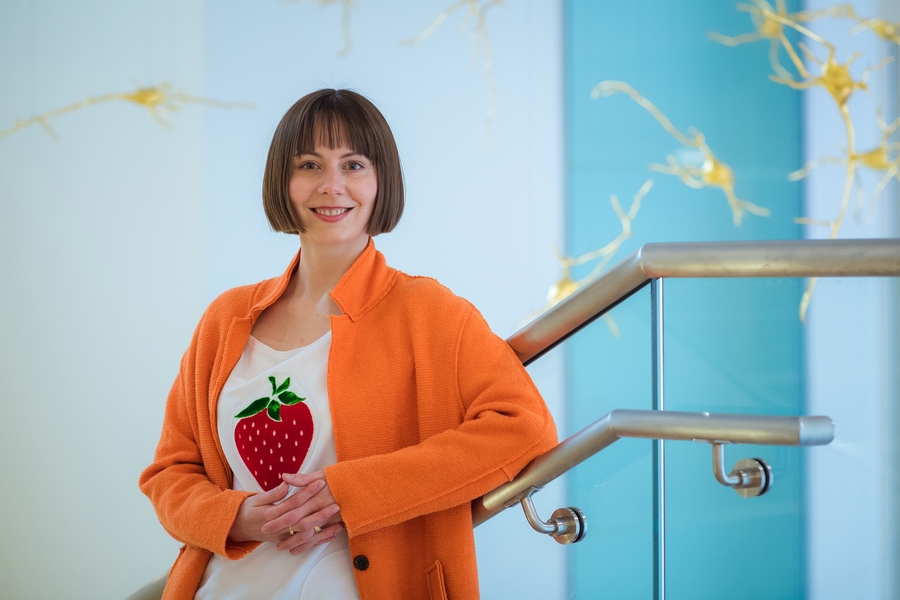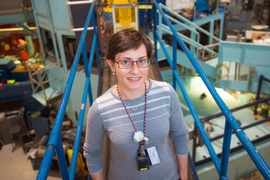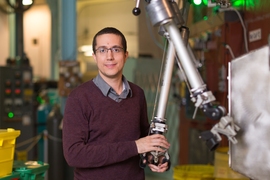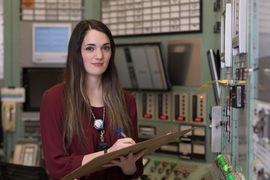Starting in 2008, as she pursued dual undergraduate degrees in physics, and nuclear science and engineering (NSE), and then a doctorate in health sciences and technology, there has been one constant in Agata Wiśniowska's life: work at MIT's Nuclear Research Laboratory (NRL).
"I've always enjoyed it," says Wiśniowska '11. "The atmosphere at the lab is so nice — it's been comfortable and welcoming, like a refuge."
During her notably venturesome academic journey, Wiśniowska has made the NRL an informal home base. It has served variously as her gateway to the world of nuclear science, a testing ground for technical competence, and a domain for practicing management skills. It has also functioned as a launchpad.
"At the lab, I gained my first supervisory experience," Wiśniowska says. "I learned to deal with different types of people, handle different situations that might arise, and confidently make decisions."
Wiśniowska's connection to the lab began the winter of her freshman year. Newly arrived to MIT from an international baccalaureate program in Poland where she had focused on physics, she was intent, she says, on "choosing as a major something I didn't already know a lot about." After sampling courses, she found nuclear science and engineering (NSE) particularly intriguing. At a departmental open house, she saw an advertisement encouraging students to train as MIT reactor operators.
"Since I was considering nuclear engineering, and I like to learn in depth from basic principles, it made sense to work at the plant and see how it operated from the inside out," she says. "I thought if I wanted to become a nuclear engineer, this would be really helpful."
In addition to an income, the reactor operator job provided unexpected benefits. "Imagine coming from a different country, with English as a second language, and receiving a manual for studying this complex system," says Wiśniowska. "I didn't understand many of the words, so I kept bugging my supervisor to explain by drawing things." While trying to master the technical demands of her job, Wiśniowska made progress in her efforts to become fluent in English.
She also received the deep immersion she sought in nuclear science and engineering. She participated in studies conducted by a range of investigators using the reactor. And several of her NSE classes centered on studies taking place at the reactor, including one involving modeling tritium radiation as it dissipated through the layers of experimental capsule of molten salt coolant.
"I could talk directly to experimenters and gain unique insights while sitting at the console as an operator," she says. "It was fun to be able to work on something very relevant to the reactor lab while also satisfying course work."
Wiśniowska found the NRL life so rewarding that in her sophomore year, she decided to expand her role and train to become a shift supervisor. She vividly recalls some of her experiences early on in this new position.
"My first reactor scram [automatic shutdown] was definitely memorable," she says. "I could hear the intercom announcement that the reactor power was decreasing, realized we had just scrammed, and knew that as supervisor, I'd have to work with the operator to figure out what to do next."
It turned out that this was no emergency, but a run-of-the-mill power dip. For Wiśniowska it was a formative moment in a long learning process. "I had this sense of uncertainty, but realized I could handle it, and later, dealing with these issues became second nature."
A new direction
By the time she reached senior year, though, Wiśniowska began to push at the constraints of her NSE studies. She had become interested in chemistry and biology, and took enough classes to minor in both fields. Medical school seemed like a possibility. For her undergraduate thesis, Wiśniowska found a way to combine her interests, researching proton irradiation therapy for liver cancer patients at Massachusetts General Hospital.
During her thesis work, she learned that the NRL had decades earlier contributed to medical studies, providing neutrons to irradiate patients with brain tumors using a technique called boron neutron capture therapy.
"I became interested in medical applications of nuclear science, but because there was no NSE program that focused on this area to the degree I hoped for, I ended up changing programs," says Wiśniowska. "While sticking with NSE would have been easier, I needed a new challenge, even if it pushed me out of my comfort zone."
Wiśniowska landed at the Harvard-MIT Program in Health Sciences and Technology (HST). A rigorous course of study, combining medical training at Boston's teaching hospitals with research, HST "felt like a beacon of possibilities," says Wiśniowska.
After doing rotations in different specialties, Wiśniowska knew she wasn't cut out to be a doctor. But she spotted a research area that simultaneously satisfied her desire to stretch herself intellectually and to improve human health: studying the brain using novel imaging techniques.
In the lab of Alan Jasanoff, an MIT professor of biological engineering, brain and cognitive sciences, and nuclear science and engineering, Wiśniowska has been able to draw on her expertise in a range of fields to develop methods for observing mechanistic molecular events in the brain.
"The research is cutting edge," she says. "We're trying to understand the elusive concept of consciousness from the molecular standpoint, getting at the question by looking at signaling molecules in the living brain."
For her doctoral work, Wiśniowska helped devise an organic sensor — a small protein — that when prompted by its small molecule target in the brain activates receptors on the smooth muscle cells lining blood vessels. This in turn triggers the cells to elongate and increase blood flow to the area, a process called vasodilation. The local increase in blood flow, indicative of detection of the target molecule, can be captured in real-time by molecular functional magnetic resonance imaging (fMRI).
"This sensor, by tapping into the contrast naturally available in blood vessels, removes the need for metal-based contrast agents normally used in molecular fMRI and allows us to image mechanistically informative molecular events in the brain with an unprecedented degree of sensitivity," says Wiśniowska. It is work that may give scientists a close up view of how neurotransmitters work to inhibit or stimulate regions in the brain.
"For the first time we may really come to understand the underlying processes of the brain, because we are developing tools that can look at the molecular aspects of signaling," she says. "The first application will involve mapping functions and determining normal brain activity, but downstream, it may be possible to diagnose people based on patterns of signaling molecules."
Ready to launch
Although pleased by the fruits of her doctoral labor, Wiśniowska decided to shift gears again. "I have contributed my bit to research, but I'd like to focus now on bringing tools like this to market." She will soon be joining the life sciences division of a consulting company, helping to evaluate and boost new biologics and medical devices.
"It will be exciting to get a sense of the business end of drug discovery, where I hope to leverage my research and insights to help companies make an impact on a range of different conditions," she says.
But even today, as she closes out her academic life at MIT and prepares for the next phase, Wiśniowska is sticking with her regular Sunday double shift (16 hours) at the NRL. "I have found it helpful staying at my desk there, with my tea mug and food supplies, rather than going back to my apartment," she says. "People at the lab motivate me to keep working on my thesis, and I’m more productive."
She also credits the NRL for helping her land her consulting job. "My work as a reactor operator is a great conversation starter in interviews," she says. "But more important, the NRL gave me my first real work experience, showing me that my decisions can have real weight, and how to take responsibility."
For the immediate future, Wiśniowska plans to stay connected. "I will continue to work as a temp and keep my license active," she says. "It's like my second home.










